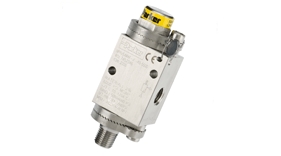

A Parker High Pressure Relief Valve (HPRV) is an automatic protection mechanism, most commonly used for process instrumentation systems. As an important pressure safety mechanism, it is important that the relief valve is correctly maintained, to ensure effective machinery operation.
This Parker HPRV user guide has been designed to help you correctly choose a high-pressure relief valve, by offering helpful information regarding the features and specifications of the valve. This will help you get the most out of your component and increase its longevity. As a CE marked and certified Category-IV component in the pressure Equipment Directive, the HPRV is designed to provide accurate and consistent cracking and resealing operation in a wide range of instrumentation applications.
Being used in such demanding applications means the Parker valve is exposed to dirt, lime scale or other harsh service conditions, which will require maintenance. Therefore, this Parker HPRV user manual provides basic maintenance and repair information, helping you to maintain the valve and troubleshoot as needed.
Below are just a few safety tips for maintaining a Parker High Pressure Relief Valve:
• When carrying out maintenance on the pressure relief valve, ensure it is isolated from any pressure source before it is removed.
• Take extra precaution and wear safety clothing when carrying out any maintenance or removing any valves from the service area. This will minimise the chances of coming into contact with toxic or corrosive fluids.
• If you are moving a pressure relief valve, take care not to carry the components by the test levers.
• Make sure the piping is supported to avoid any excessive stress on the body or bonnet.
• Stand clear of the discharge side of a pressure relief valve
• During installation, ensure the pressure relief valve is installed in the vertical upright position, to ensure effective operation.
The innovative Parker HPRV provides a universal solution for instrumentation and manufacturing applications. The versatile valve is designed to provide accurate and consistent cracking and resealing performance, suitable for all pressures between 150-6000psi.
The High-Pressure Relief Valve features pressure settings which are externally adjustable, with six different spring ranges, providing greater system sensitivity and enhanced performance. The colour coded springs and labels indicate the spring cracking range, with multiple end connections available.
The Parker HPRV has a maximum cold working pressure of 6000psi (414 bar) and up to 8000 psi (552 bar) during relief with no internal seal damage. The valve also features a maximum back pressure of 2000 psi (137.9 bar).
In terms of cracking pressure, the valve features eight springs, from 150 psi to 6000 psi in the following ranges:
• 150-375 psi
• 325-775 psi
• 725-1525 psi
• 1475-2275 psi
• 2225-3025 psi
• 2975-4025 psi
• 3975-5025 psi
• 4975-6000 psi.
Parker HPRV features, include:
• Colour coded springs and labels, which indicate spring cracking range.
• Captured moulded seat design, which is resistant to blow out and chips.
• Tru-Loc facility to prevent accidental adjustment.
• Lock wire feature to secure a given pressure setting.
• Low friction stem seal design to prevent friction which increases accuracy of cracking pressure and reseat pressure.
• Balanced poppet design for consistent cracking pressure regardless of system back pressure.
• Multiple end connection.
The Parker HPRV is available with four different end connections:
• Single ferrule CPI compression port.
• Two ferrule A-LOK compression port.
• ANSI/ASME B1.20.1 external pipe threads.
• ANSI/ASME B1.20.1 internal pipe threads.
Fluid Controls are leading Parker suppliers. We are able to supply high-pressure relief valves for almost any application, to meet your exact specifications. For more information or to place an order, contact our technical team today by emailing fluid@fluidcontrols.co.uk or calling 0118 970 2060.